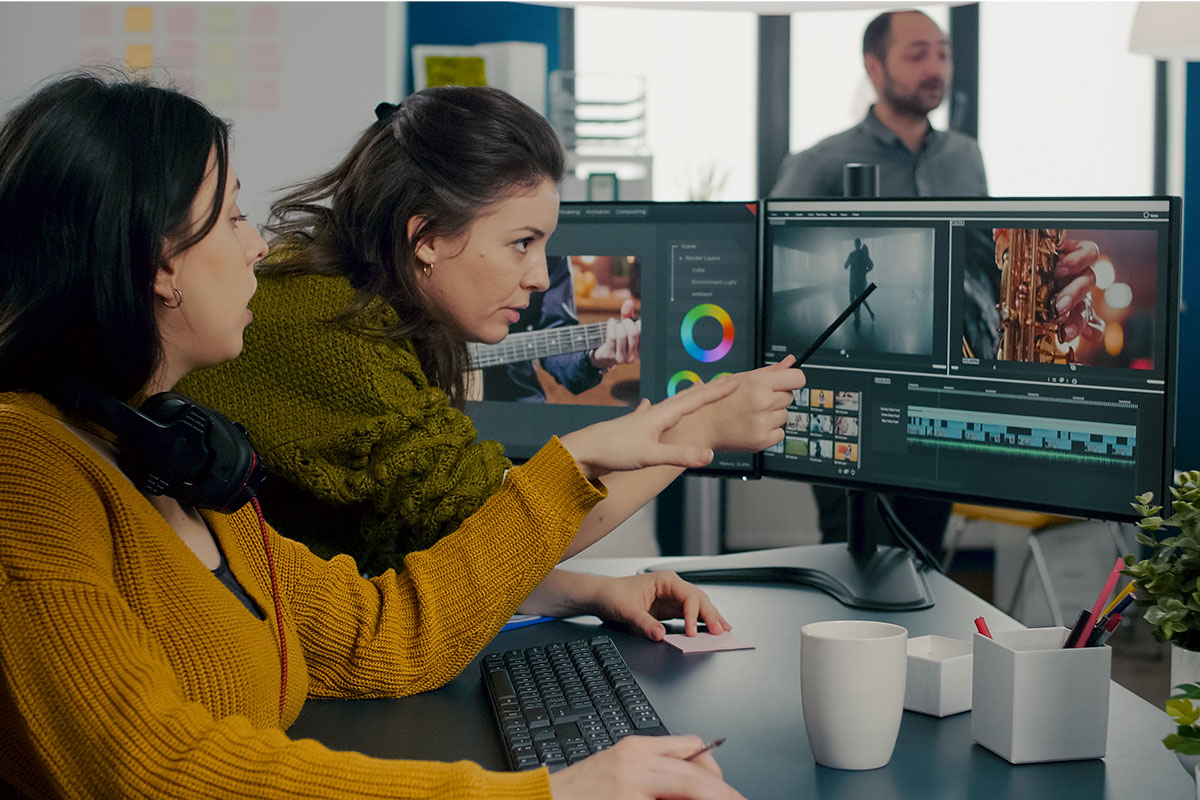
Video Production Agencies: A Guide to Post-Production
Imagine this: You have just signed on with a video production agency for a big new project, and the excitement is palpable. You can already picture the final video in your head—the one that is going to wow your audience and make an impact. The day of the shoot arrives, and everything goes according to plan. The crew is on point, the cameras are rolling, and before you know it, you have wrapped up the shoot without a hitch. It almost feels like the job is done, right? Everyone deserves a pat on the back for a job well done, and you can almost hear the applause. But before you start celebrating, there is one thing that has not been taken into account: the behind-the-scenes work that happens once filming ends. This is where post-production steps in, and it is far more than just a few quick edits. Post-production is where your footage is truly transformed into the video you have envisioned. Without this crucial stage, that successful shoot might not lead to the impact you expect. In this article, we will walk you through the entire post-production process—step by step—showing you what video production agencies do to take your raw footage and turn it into a finished product ready to share with the world.
1. Ingesting and Organising Raw Footage
The first step in post-production involves ingesting and organising the raw footage. Ingesting refers to the process of importing the footage from cameras or storage devices into the editing system. This is an essential task because without this initial step, there is no content to edit. Video production agencies often employ specialised software and tools to manage large quantities of footage efficiently. These tools allow for tagging, logging, and even transcoding files into formats optimised for editing, helping to streamline the entire workflow.
Once the footage is in the system, it is important to organise the clips in a way that allows for easy retrieval. This typically involves creating folders, labelling clips by scene or shot, and sometimes even colour coding them to differentiate between takes or versions. This organisational phase is important because it saves time in the later stages of editing, especially when dealing with large amounts of footage from multiple cameras.
2. Editing
With raw footage organised, the next step is editing. Editing involves arranging the clips into a cohesive sequence. Editors will start by creating a rough cut, which is a rough version of the film or video that arranges the clips in their approximate order. The goal at this stage is to establish the basic structure of the video, whether it is a linear story, a commercial, or a product demo.
Once the rough cut is in place, the editor refines it by adjusting the pacing, cutting unnecessary footage, and ensuring continuity between shots. This phase involves not just trimming down clips, but also selecting the best takes and sometimes adjusting the timing of certain moments to create a smoother flow. It is a delicate balance of making sure the video fits within the intended duration and maintaining a fluid narrative.
3. Visual Effects (VFX) and Animation
After the video is edited, visual effects (VFX) and animation come into play. Visual effects involve adding computer-generated imagery (CGI) to enhance or alter the video. This might include things like creating explosions, adding digital backgrounds, or altering environments that were not possible during filming.
In addition to VFX, animation can be introduced in the form of motion graphics or animated sequences. This could range from a simple logo animation for a brand video to more complex 2D or 3D animation for a commercial or explainer video.
Many video production agencies also specialise in VFX and animation, ensuring there is no disconnect between these elements and the rest of the video. Choosing an agency that offers multiple services is beneficial because it eliminates the logistical challenges of coordinating multiple teams, reducing the risk of a final product lacking cohesiveness, while also cutting down on the costs associated with working with several different teams.
4. Colour Correction and Grading
Colour correction and grading is another key step in post-production. Colour correction ensures that the footage looks consistent across all shots by adjusting the brightness, contrast, and colour balance. Sometimes, certain shots may appear too dark or too bright, or the colours may look unnatural. Colour correction is the process of fixing those issues.
After colour correction, colour grading is applied to give the video its final look and feel. Colour grading is the artistic side of colour work, where colourists manipulate the footage to achieve the desired mood. For example, a documentary might have a natural, neutral colour grade, while a high-energy commercial might use warmer or cooler tones to create a particular feeling.
5. Sound Design and Editing
Sound is a vital part of any video production. In post-production, sound design and editing work to enhance the audio experience. Sound editing involves cleaning up audio, synchronising dialogue with the video, and removing any unwanted background noise. For example, if there is a hum or hiss in the audio, sound editors will remove it to ensure clear audio.
Sound design, on the other hand, includes adding any additional sound effects or sounds that were not recorded during filming. This could involve adding ambient sounds, footsteps, car engines, or any other sound that complements the visuals.
6. Sound Mixing
Once sound editing and design are complete, sound mixing begins. This is the process of balancing all the audio elements—dialogue, sound effects, music, and any ambient noise—to ensure they work together harmoniously.
The goal of sound mixing is to make sure that dialogue is clear, the background music is not overpowering, and the sound effects complement the visuals. The mix is then fine-tuned to match the video’s emotional tone, whether it is a calm, introspective scene or a high-action moment.
7. Mastering and Output
After the video has been edited, colour-graded, and sound-mixed, the final step is mastering. Mastering involves finalising the video and audio to ensure it is formatted correctly for distribution across different platforms. This stage includes exporting the video in multiple formats, such as those required for YouTube, social media, or broadcast television.
The mastering process also includes checking that the audio levels are consistent and ensuring that all technical aspects, such as resolution, file formats, and compression, meet industry standards.
Client Feedback and Implementation
While not a stage that happens after the video is complete, client feedback plays a significant role throughout the post-production process. During the editing phase, a rough cut of the video is typically shown to the client, allowing them to provide feedback. This can include changes to the narrative, pacing, or any visual elements. Video production agencies work closely with clients throughout the process, implementing feedback to refine the video and ensure it aligns with the client’s expectations.
The feedback is then carefully considered, and necessary adjustments are made to the video. Whether it is adjusting the tone, fixing specific shots, or revisiting certain effects, the post-production team works to implement the client’s feedback while maintaining the overall vision of the video. Once all feedback is incorporated and the client is satisfied with the final product, the video is approved for the mastering and output stage.
Conclusion
Now that you have had a closer look at the post-production process, you can see why it is often referred to as the true “magic” of video production. It is the stage where all those hours of filming are transformed into something polished, cohesive, and ready to captivate an audience. Whether it is editing, sound design, or VFX, the work that goes into post-production is what ultimately brings your project to life—often in ways you may never have imagined during the shoot.
To put it into perspective, did you know that a significant portion of a film’s budget—sometimes up to 50%—is spent on post-production? It is no wonder that video production agencies dedicate so much time and expertise to ensuring this part of the process is handled with care. Without post-production, all those brilliant ideas captured on camera would just be… well, footage. So, next time you are working on a project, remember: the shoot might be over, but the real work is just beginning. And that is where the magic happens.
Don’t let your footage sit untouched—let us work our magic behind the scenes. From editing to animation, Sound Idea Digital specialises in turning your ideas into a final cut that wows. Get in touch with us today.
We are a full-service Web Development and Content Production Agency in Gauteng specialising in Video Production, Animation, eLearning Content Development, Learning Management Systems, and Content Production.
Contact us for a quote. | enquiries@soundidea.co.za | https://www.soundideavideoproduction.co.za| +27 82 491 5824 |

